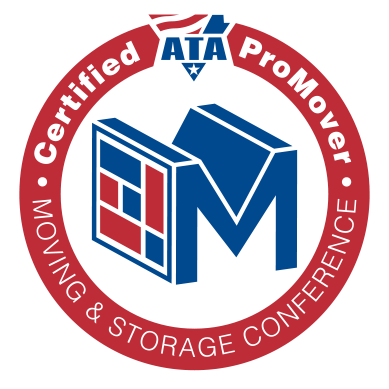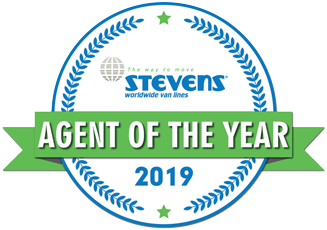- Do I Need A Mover?
- What Kind Of Mover Do I Need?
- How To Choose The Right Moving Company For You
- Types of Moves
- How To Hire A Mover
- How To Make An Accurate Inventory of Your Belongings
- Questions To Ask A Mover
- Questions Your Triangle Movers Inc. Representative Will Need To Know
- Call The Mover
- What To Do On Move Day
- What To Do At The New Location
- After The Move
- Moving Glossary
A BUYER’S GUIDE FOR HOUSEHOLD MOVES
The average American changes their residence 11.3 times throughout their life.
Ben Franklin said, Moving three times is as bad as a fire. That 18th-century adage is no longer true — especially when you have professional movers like Triangle Movers Inc. by your side.
No matter if this is your first move or your fifteenth, we know that moving is inherently stressful and can be downright confusing.
This guide will walk you through the top questions and concerns to ask when hiring a moving company and completing a move. We encourage your questions throughout the process. Most of the professional movers you’ll meet are down-to-earth people running a family business helping people like you.
You may move only 11 times in your life. At Triangle Movers Inc., we move families like yours every day.
Do I Need A Mover?
You may think a DIY move is for you, but there are often tips, tricks and, most important, proper tools and equipment professional movers have access to that you may not.
- How much does it cost to have someone move you?
- The cost to hire a mover varies based on the inventory of your move and its weight.
- Movers also charge an hourly fee for labor, which includes their travel time.
- How much does packing cost?
- Our professional packing services are based on an hourly rate plus travel feel and the cost for materials.
- Do I need insurance for my move?
- The details of what your insurance covers depend on your policy. Moving and storage companies can’t sell insurance per se, but they can provide valuation options. See the Moving Glossary for more explanation.
What Kind Of Mover Do I Need?
If you’re looking to downsize or rightsize your office, or if you’re simply changing homes, we have moving and storage services ranging from local and long distance to office and corporate relocation that depend on:
- How far away you’re moving.
- How many rooms you’re moving.
- If you require specialty services (moving a pool table, wine cellar, gun safe, hot tub or a piano.
- If there is furniture that requires disassembly or reassembly at the new location.
How To Choose The Right Moving Company For You:
- Get estimates in writing.
- Eliminate confusion and miscommunication.
- Talk to 2-3 companies.
- Compare what they have to offer and at what price.
- Do this about six weeks ahead of time, or sooner if you’re moving in the busy summer months.
- Are they licensed and insured?
- Make sure you’re covered in the event of an accident.
- Ask for the license number and insurance carrier.
- Are they family-owned and operated?
- If there is a problem, talking to the owner is best.
- How long have they been in business?
- Experience makes a difference.
- Read reviews.
- Don’t look just at the five-star recommendations. Also, look to see the common complaints people reported and how the company offered to rectify them.
Types of Moves
Full-Service Move
Full-service moving includes furniture disassembly and reassembly. Just like the name says, it’s full service. The customer doesn’t need to lift a finger. Busy professionals often choose this option, as it takes the stress out of moving. Many companies also offer partial-service plans and customized moving plans.
DIY Move
Packing, lifting and transporting your own items.
You will probably find it beneficial to rent trucks and dollies, especially for heavy items.
Labor-Only Moves
The middle ground between full-service and DIY moves. Hire movers for a few hours to help load/unload your goods. Labor only is a time- and energy-saving move if you don’t mind packing your own items but would like some help with the heavy lifting.
How To Hire A Mover
What information to have ready before calling a mover:
- Date and time of your move.
- What services you will need: Will you need optional packing? Will you need storage or packing supplies?
- Do you have any specialty items you plan to move?
- Know your budget. How much are you willing to spend for moving help?
Fill out an online estimate form
- Most moving companies will have an opportunity to fill out a free moving estimate form on their website. Ours is on the right of this page. Once you narrow down the movers you are interested in using, fill out their online estimate forms to get a estimate on your moving cost.
How To Make An Accurate Inventory Of Your Belongings
- Start with a clipboard.
- Create a new sheet for each room.
- Go through each room and note:
- Furniture (will it need disassembly?)
- Items that will be boxed and the type of box (book box, medium box, large box, specialty box).
- Items that will need special consideration (artwork; large, bulky items; TVs; mirrors).
- Items that are on hangers.
- Don’t forget to look in closets, the attic and the garage.
- Put all sheets together in a moving binder, where you can also store receipts and paperwork from the moving company.
Questions To Ask A Mover
- Do they provide boxes or totes?
- What types of boxes will I need for my move?
- How many boxes will I need for my move?
- While it may be tempting to find cheap moving boxes or ask for boxes at the grocery store, as experienced movers, we recommend that you buy quality cardboard boxes that are designed for moving and which have the structural integrity to allow for stacking. Triangle sells moving boxes.
- Do they supply totes? How many will I need?
- What types of moving supplies do they offer (wardrobe boxes, moving blankets, dish boxes, mattress bags, flat-screen TV boxes)?
- Can wardrobe boxes be borrowed instead of purchased?
- Do I have to unpack my dresser drawers?
- If it’s a sturdy, well-made dresser being moved from home to home, you can leave clothes in the drawers.
- Flimsy dressers should be emptied.
- If you’re moving a dresser to storage, the drawers must be empty.
- Which Items Are Movers Prohibited From Transporting?
- Combustible liquids (rubbing alcohol, antifreeze, cleaning materials).
- Corrosive liquids (acid, bleach).
- Explosives (fireworks, ammunition, dynamite).
- Flammables (aerosol cans, gasoline, kerosene, ammonia, propane, scuba tanks).
- Food items (nothing perishable, subject to freezing or sold in a bag or box).
- Plants (no live plants or soil).
- Which Items Should I Move Myself?
- Any of the items listed above, if it is safe and legal to do so.
- Important documents
- Birth certificates
- Passports
- Mortgage papers and contracts
- Laptop computer
- Medications
- Jewelry
- Money and coins
- Pets
- Emergency kit
- Moving company contract
- Can a mover move a car?
- If you have a collector car or a spare car in storage, you can discuss auto transport options with us.
Questions Your Triangle Movers Inc. Representative Will Need To Know:
- How many floors is your home?
- We’ll make sure to bring the right tools and equipment and the correct number of crewmembers
- Stairs may add overall time to the move.
- If your building has elevators, reserve one in advance.
- Do you have a flat-screen TV?
- We can build a box for it, if you don’t have the original.
- Do you have antiques?
- We will outline valuation coverage and discuss how to pack or crate the items.
- Do you want someone to help you pack?
- We offer full-service packing and partial packing, based on your needs.
- Do you want additional insurance coverage?
- Valuation coverage is optional added liability insurance. If you choose full replacement value protection, the mover will repair the article to the extent necessary to restore it, pay you for the cost of repairs or replace the article with an article of like kind and quality. Without this coverage, the mover is required to reimburse you for the item based on its weight, at 60 cents per pound.
- Is your location accessible by our truck?
- If your location is on a hill or in a hilly area, we will need to prepare.
- For inaccessible locations, we may need to arrange for a shuttle service to load items into a smaller vehicle for the final destination.
- Is there a place to park in front?
- Where will the movers park in relation to your front door?
- Will we need a permit for street parking?
- How to handle an inventory (virtual or in person):
- We will call you to go over the items in your home, room by room to document furniture, artwork and items that will need to be boxed. Based on our years of experience, we have developed a software system that provides an accurate estimate.
- Be upfront with the mover about all of your items, so we can establish an accurate inventory and estimate.
- Be sure to tell them things you don’t want packed.
- Most movers work fast. Label the items you don’t want loaded.
- Designate a room or space for these things.
Call The Mover
Once you have received your estimates, you should be able to choose a mover that meets your needs and your budget. Call the mover you are most inclined to hire and ask them more specific questions about your move, such as the type of services you need, and ask if they are available for your moving dates.
What To Do On Move Day
On moving day, you need to:
- Be present for questions and direct the movers where to go.
- Review documents.
- Create and review your own inventory checklist.
- Sign the driver’s inventory list.
- Provide payment.
What To Do At The New Location
- Set up cable, phone, Wi-Fi and yard maintenance.
- Talk to the cable installers and other utility-related services for your new home four weeks ahead of the move to arrange for connection.
- Have utilities turned on a day before your move.
- Arrange to have utilities turned off at your old home a day after you move out.
- Do you need a cleaning service?
- The best time to deep clean a house is before you move in.
- Consider scheduling a cleaning crew a day or two ahead of the move.
- Do you need people to unpack?
- We offer unpacking services to help you move in quickly.
- We can place your items on a counter for you to put away or place them in the cupboards and closets.
- We can haul away and recycle empty boxes.
After The Move
-
- What to do if something is broken during the move or is missing after the move:
- Call your moving company and make a report. They may have a system for finding misplaced items.
- Consider filing a claim with the moving company.
- Have any proof of your item, such as photos from the move or your inventory list.
- How to file a claim.
- Call your moving company and ask how they file claims.
- Here are some pro tips when it comes to preparing for a claim:
- Be sure to keep your broken items.
- Don’t throw them away, but set them aside in case the damage must be inspected for your claim.
- Submit claims as soon as possible, in order to expedite the process.
- If you notice a missing or broken item on the day of the move, be sure to say something to your movers right then to protect your rights. If you don’t, it’s hard to prove who is at fault.
- How much will I recover as compensation?
- What to do if something is broken during the move or is missing after the move:
Don’t expect to get full value back for your lost or damaged item. The moving company may ask how much you paid for the item or what the condition was before. You may be able to negotiate how much you receive back, but this is up to the moving company itself.
-
- Full or partial valuation: If you opted to pay for full valuation for your moving company, you will receive more compensation for your item. Valuation is typically dependent on the weight of your items and can be as low as receiving back $0.60/pound of your item.
- Movers are able to limit their liability coverage on more expensive items. However, the exact cost of value protection varies by mover, so it is beneficial to ask your mover about their plans and have a clear understanding of your rights before signing the paperwork.
- Let the company know if you are not happy. Or leave a positive review online.
- Bad experience? Contact the moving company. More than likely, they will have policies and procedures set in place.
- Good experience? Leave a review for them on Google or Yelp to let others know they are a great company to work with. Informing the moving company about your experience also helps them to better serve their customers by informing them what they did right and what they can do better.
Moving Glossary
Moving is a specialized industry, and you’re likely to come across unfamiliar terms. We’re here to break down commonly used moving terms and what you need to know:
Accessorial/Additional Charge: Charges for additional services, such as packing/unpacking.
- These charges may show up for unexpected issues during your move, such as having to use a shuttle service.
Bill of Lading: This is your receipt or contract with your mover.
- Read the bill of lading before you accept it.
- Ask your moving company questions if you don’t understand something.
- By signing this bill of lading, you are entrusting all your belongings to the mover for transportation.
Binding/Non-Binding Estimate: This is what is provided before the move as an estimate of how much the move will cost. The full charge amount will be given after the move is complete.
- Binding: The mover quotes a flat price based on a given inventory. No matter how long the job takes, the flat price is always paid. It is given only when an onsite estimate is performed.
- Non-Binding: These estimates are based on the movers’ previous experience of jobs similar to yours. As the name suggests, these estimates are subject to change.
Carrier: The mover or company you’re working with.
C.O.D.: Stands for “cash on delivery.”
- Payment is required at the time of delivery (before the move).
- Some movers take cash, cashier’s checks or money orders.
- Be sure to discuss payment options with your mover before your moving date.
High-Value Article: An item valued at about $100 per pound.
- You might need to fill out an inventory form for each item considered a high-value article.
Interstate Move: Any move that crosses state boundaries, regardless of miles.
Intrastate Move: A move within the state.
Order for Service: The document that authorizes the moving company to move your items.
Order Number: The number used to identify and track your shipment. It will be found on your order for service and the bill of lading.
Shuttle Service: When a smaller vehicle is used to transport your shipment to its destination. This usually happens when a road is too narrow or there isn’t enough parking to get the moving truck to its destination.
Storage In Transit (S.I.T.): Temporary storage for your belongings if your new home isn’t ready.
- The time in storage may not exceed more than 180 days.
- Note that you will be charged for storage fees.
Valuation: This is not insurance, but a specific amount a moving company agrees to pay if an item is damaged or lost by a mover.
- Options for minimum or full coverage.
- Federally regulated.
- Often determined by the weight of goods.
Now, you’re fully armed with all the knowledge you need to make a successful move. You know what to look for in movers, what to pack and some frequently used terms to help you navigate your moving contract. You are at an advantage — you’re going into this process knowing more than the average person.
Moving is stressful. But you’ve got this!






















